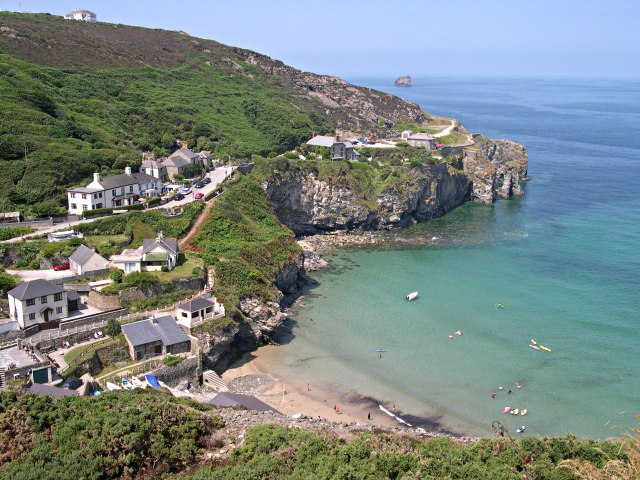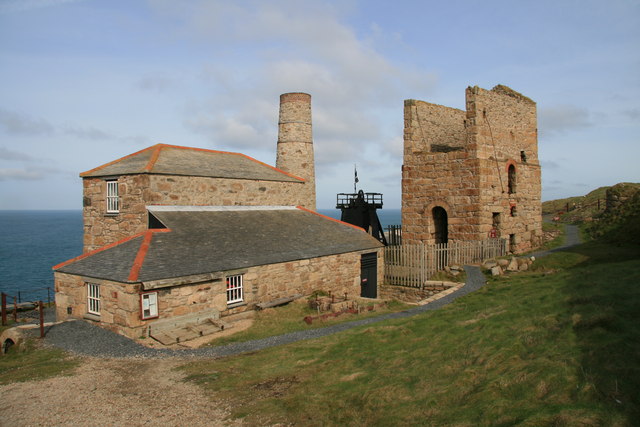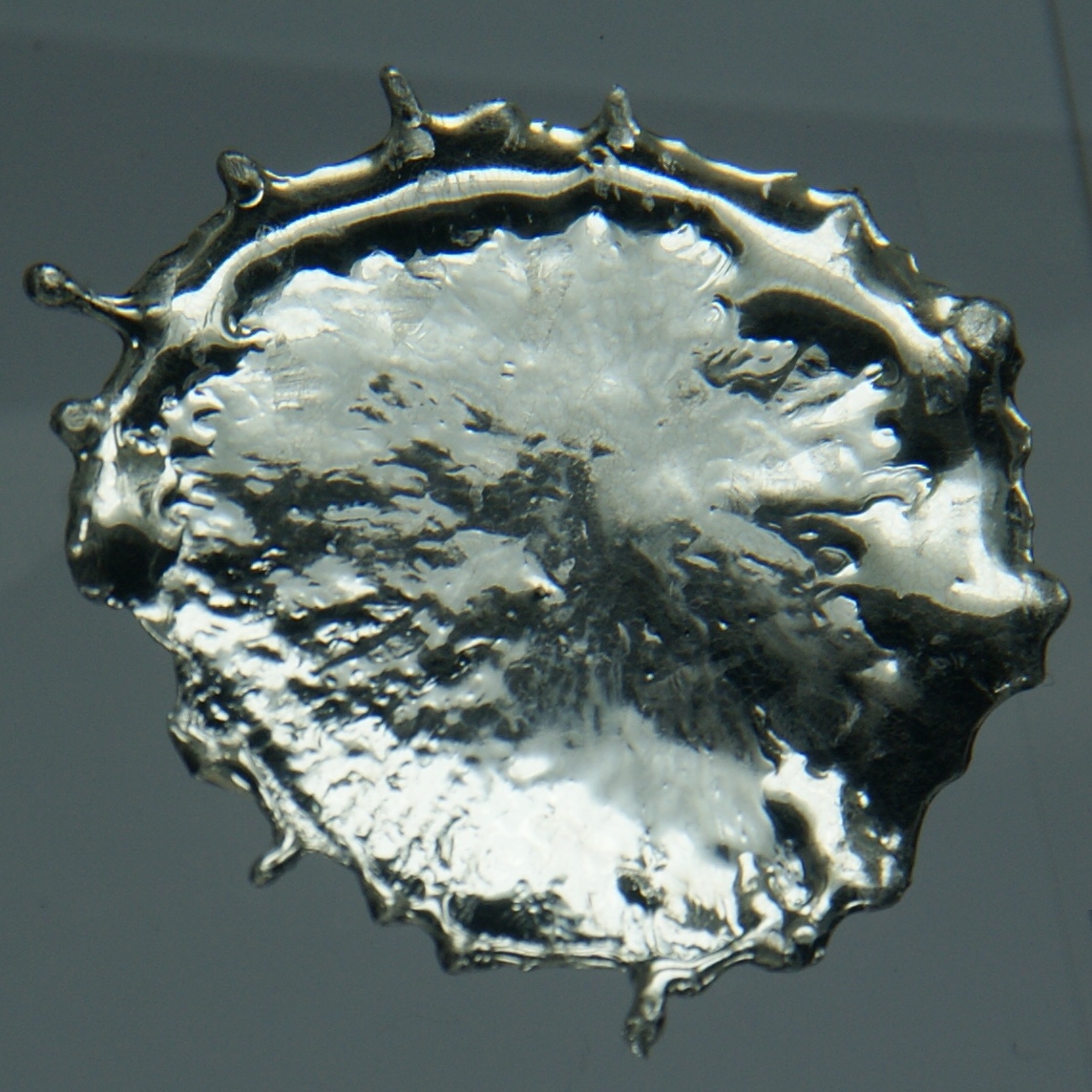|
Wheal Coates Tin Mine
Wheal Coates is a former tin mine situated on the north coast of Cornwall, UK, on the cliff tops between Porthtowan and St Agnes. It is preserved and maintained by the National Trust. History Earliest records indicate a mine at the site since 1692. The present mine opened in 1802 and was closed in 1889 when the price of tin fell. It came into full production in 1815. Flooding and bringing ore to the surface were the main problems of the mine until steam-driven equipment was available, as the mine's underground operations extended for some distance under the sea. The mine was sold in 1844 and thereafter allowed to flood. A new owner reopened the mine in 1872 but work was sporadic until its 1889 closure. For some years, the yield was 20lb of tin per ton of ore. In 1906, new ownership hoped to work the mine for both tin and copper. Wheal Coates had produced a small amount of copper ore, more than a century earlier. At the height of its production, 140 people were employed at the ... [...More Info...] [...Related Items...] OR: [Wikipedia] [Google] [Baidu] |
St Agnes, Cornwall
St Agnes ( kw, Breanek) is a civil parish and a large village on the north coast of Cornwall, UK. The village is about five miles (8 km) north of Redruth and ten miles (16 km) southwest of Newquay. ''and'' An electoral ward exists stretching as far south as Blackwater. The population at the 2011 census was 7,565. The village of St Agnes, a popular coastal tourist spot, lies on a main road between Redruth and Perranporth. It was a prehistoric and modern centre for mining of copper, tin and arsenic until the 1920s. Local industry has also included farming, fishing and quarrying, and more recently tourism. The St Agnes district has a heritage of industrial archaeology and much of the landscape is of considerable geological interest. There are also stone-age remains in the parish. The manor of Tywarnhaile was one of the 17 Antiqua maneria of the Duchy of Cornwall. Geography St Agnes, on Cornwall's north coast along the Atlantic Ocean, is in the Pydar hundred ... [...More Info...] [...Related Items...] OR: [Wikipedia] [Google] [Baidu] |
Cornwall
Cornwall (; kw, Kernow ) is a historic county and ceremonial county in South West England. It is recognised as one of the Celtic nations, and is the homeland of the Cornish people. Cornwall is bordered to the north and west by the Atlantic Ocean, to the south by the English Channel, and to the east by the county of Devon, with the River Tamar forming the border between them. Cornwall forms the westernmost part of the South West Peninsula of the island of Great Britain. The southwesternmost point is Land's End and the southernmost Lizard Point. Cornwall has a population of and an area of . The county has been administered since 2009 by the unitary authority, Cornwall Council. The ceremonial county of Cornwall also includes the Isles of Scilly, which are administered separately. The administrative centre of Cornwall is Truro, its only city. Cornwall was formerly a Brythonic kingdom and subsequently a royal duchy. It is the cultural and ethnic origin of the Cornish dias ... [...More Info...] [...Related Items...] OR: [Wikipedia] [Google] [Baidu] |
Porthtowan
Porthtowan ( kw, Porth Tewyn, meaning ''cove of sand dunes'') is a small village in Cornwall, England which is a popular summer tourist destination. Porthtowan is on Cornwall's north Atlantic coast about west of St Agnes, north of Redruth, west of Truro and southwest of Newquay in the Cornwall and West Devon Mining Landscape, a World Heritage Site. Porthtowan is popular with surfers and industrial archaeologists; former mine stacks and engine houses dot the landscape. Geography Porthtowan lies along the Godrevy Head to St Agnes heritage coast, which is located on the north Cornwall coast of the Celtic Sea in the Atlantic Ocean. It lies between Godrevy Head (with the Godrevy Towans) and St Agnes Head, north of the village of St Agnes.Ordnance Survey: Landranger map sheet 203 ''Land's End'' ''St Agnes Herita ... [...More Info...] [...Related Items...] OR: [Wikipedia] [Google] [Baidu] |
National Trust
The National Trust, formally the National Trust for Places of Historic Interest or Natural Beauty, is a charity and membership organisation for heritage conservation in England, Wales and Northern Ireland. In Scotland, there is a separate and independent National Trust for Scotland. The Trust was founded in 1895 by Octavia Hill, Sir Robert Hunter and Hardwicke Rawnsley to "promote the permanent preservation for the benefit of the Nation of lands and tenements (including buildings) of beauty or historic interest". It was given statutory powers, starting with the National Trust Act 1907. Historically, the Trust acquired land by gift and sometimes by public subscription and appeal, but after World War II the loss of country houses resulted in many such properties being acquired either by gift from the former owners or through the National Land Fund. Country houses and estates still make up a significant part of its holdings, but it is also known for its protection of wild lands ... [...More Info...] [...Related Items...] OR: [Wikipedia] [Google] [Baidu] |
Bal Maiden
A bal maiden, from the Cornish language , a mine, and the English "maiden", a young or unmarried woman, was a female manual labourer working in the mining industries of Cornwall and western Devon, at the south-western extremity of Great Britain. The term has been in use since at least the early 18th century. At least 55,000 women and girls worked as bal maidens, and the actual number is likely to have been much higher. While women worked in coal mines elsewhere in Britain, either on the surface or underground, bal maidens worked only on the surface. It is likely that Cornish women had worked in metal mining since antiquity, but the first records of female mine workers date from the 13th century. After the Black Death in the 14th century, mining declined, and no records of female workers have been found from then until the late 17th century. Industrial improvements, the end of Crown control of metal mines, and rising demand for raw materials caused a boom in ... [...More Info...] [...Related Items...] OR: [Wikipedia] [Google] [Baidu] |
Cornish Engine
A Cornish engine is a type of steam engine developed in Cornwall, England, mainly for pumping water from a mine. It is a form of beam engine that uses steam at a higher pressure than the earlier Watt steam engine, engines designed by James Watt. The engines were also used for powering man engines to assist the underground miners' journeys to and from their working levels, for winching materials into and out of the mine, and for powering on-site stamp mill, ore stamping machinery. Background: The steam engine in Cornwall Cornwall has long had tin, copper and other metal ore mines, but if mining is to take place at greater depths, a means to dewatering, dewater the mine must be found. Lifting the weight of water up from the depths requires great amounts of work (physics), work input. This energy may be weakly supplied by horse power or a waterwheel to operate pumps, but horses have limited power and waterwheels need a suitable stream of water. Accordingly, the innovation of c ... [...More Info...] [...Related Items...] OR: [Wikipedia] [Google] [Baidu] |
Calcination
Calcination refers to thermal treatment of a solid chemical compound (e.g. mixed carbonate ores) whereby the compound is raised to high temperature without melting under restricted supply of ambient oxygen (i.e. gaseous O2 fraction of air), generally for the purpose of removing impurities or volatile substances and/or to incur thermal decomposition. The root of the word calcination refers to its most prominent use, which is to remove carbon from limestone (calcium carbonate) through combustion to yield calcium oxide (quicklime). This calcination reaction is CaCO3(s) → CaO(s) + CO2(g). Calcium oxide is a crucial ingredient in modern cement, and is also used as a chemical flux in smelting. Industrial calcination generally emits carbon dioxide (), making it a major contributor to climate change. A calciner is a steel cylinder that rotates inside a heated furnace and performs indirect high-temperature processing (550–1150 °C, or 1000–2100 °F) within a controlled ... [...More Info...] [...Related Items...] OR: [Wikipedia] [Google] [Baidu] |
Arsenic
Arsenic is a chemical element with the symbol As and atomic number 33. Arsenic occurs in many minerals, usually in combination with sulfur and metals, but also as a pure elemental crystal. Arsenic is a metalloid. It has various allotropes, but only the gray form, which has a metallic appearance, is important to industry. The primary use of arsenic is in alloys of lead (for example, in car batteries and ammunition). Arsenic is a common n-type dopant in semiconductor electronic devices. It is also a component of the III-V compound semiconductor gallium arsenide. Arsenic and its compounds, especially the trioxide, are used in the production of pesticides, treated wood products, herbicides, and insecticides. These applications are declining with the increasing recognition of the toxicity of arsenic and its compounds. A few species of bacteria are able to use arsenic compounds as respiratory metabolites. Trace quantities of arsenic are an essential dietary element in rats, ham ... [...More Info...] [...Related Items...] OR: [Wikipedia] [Google] [Baidu] |
Cornwall And West Devon Mining Landscape
The Cornwall and West Devon Mining Landscape is a World Heritage Site which includes select mining landscapes in Cornwall and West Devon in the south west of England. The site was added to the World Heritage List during the 30th Session of the UNESCO World Heritage Committee in Vilnius, July 2006. Following plans in 2011 to restart mining at South Crofty, and to build a supermarket at Hayle Harbour, the World Heritage Committee drafted a decision in 2014 to put the site on the List of World Heritage in Danger, but this was rejected at the 38th Committee Session at Doha, Qatar (July 2014), in favour of a follow-up Reactive Monitoring Mission. History Up to the mid-16th century, Devon produced approximately 25-40% of the amount of tin that Cornwall did but the total amount of tin production from both Cornwall and Devon during this period was relatively small. After the 1540s, Cornwall's production took off and Devon's production was only about between a ninth to a tenth of that of C ... [...More Info...] [...Related Items...] OR: [Wikipedia] [Google] [Baidu] |
World Heritage Site
A World Heritage Site is a landmark or area with legal protection by an international convention administered by the United Nations Educational, Scientific and Cultural Organization (UNESCO). World Heritage Sites are designated by UNESCO for having cultural, historical, scientific or other form of significance. The sites are judged to contain " cultural and natural heritage around the world considered to be of outstanding value to humanity". To be selected, a World Heritage Site must be a somehow unique landmark which is geographically and historically identifiable and has special cultural or physical significance. For example, World Heritage Sites might be ancient ruins or historical structures, buildings, cities, deserts, forests, islands, lakes, monuments, mountains, or wilderness areas. A World Heritage Site may signify a remarkable accomplishment of humanity, and serve as evidence of our intellectual history on the planet, or it might be a place of great natural beauty. A ... [...More Info...] [...Related Items...] OR: [Wikipedia] [Google] [Baidu] |
Tin Mines In Cornwall
Tin is a chemical element with the symbol Sn (from la, stannum) and atomic number 50. Tin is a silvery-coloured metal. Tin is soft enough to be cut with little force and a bar of tin can be bent by hand with little effort. When bent, the so-called "tin cry" can be heard as a result of twinning in tin crystals; this trait is shared by indium, cadmium, zinc, and mercury in the solid state. Pure tin after solidifying presents a mirror-like appearance similar to most metals. In most tin alloys (such as pewter) the metal solidifies with a dull gray color. Tin is a post-transition metal in group 14 of the periodic table of elements. It is obtained chiefly from the mineral cassiterite, which contains stannic oxide, . Tin shows a chemical similarity to both of its neighbors in group 14, germanium and lead, and has two main oxidation states, +2 and the slightly more stable +4. Tin is the 49th most abundant element on Earth and has, with 10 stable isotopes, the largest nu ... [...More Info...] [...Related Items...] OR: [Wikipedia] [Google] [Baidu] |







